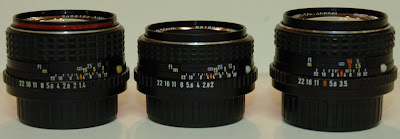Here are three of my Pentax's. Two 50's and a 28mm, these are the main stay of my shooting with Pentax. "Ah," you say, those who have been paying attention, "Don't you have other lenses that fit the 'K' mount?" Yes is the right answer. The 28mm does the bulk of the work. See the 50mm f/1.4 on the right? It went to Puerto Rico, and took a grand total of one picture, because I remembered I had it. The 28 got the rest, I'm a wide see-er, and 24 to 35 does me just fine. Does somebody make that in a zoom?
 Here is the front view of these lenses, from this angle it is apparent that the holes in the middle are different. This is called the aperture, in this case, the maximum aperture. The apertures let in light, if the aperture is smaller less light goes in, if larger; more. That seems simple and it is but here comes the catch, (there is always a catch). It is easier to make a sharp small aperture lens than a sharp large aperture lens. That is why, the super fast lenses are more expensive than the slower. The other social thing, "Look, he has a bunch of super fast (expensive, professional) lenses and that guy has slower (cheaper, amateur) therefore he is a better photographer" Which couldn't be further from the truth.
Here is the front view of these lenses, from this angle it is apparent that the holes in the middle are different. This is called the aperture, in this case, the maximum aperture. The apertures let in light, if the aperture is smaller less light goes in, if larger; more. That seems simple and it is but here comes the catch, (there is always a catch). It is easier to make a sharp small aperture lens than a sharp large aperture lens. That is why, the super fast lenses are more expensive than the slower. The other social thing, "Look, he has a bunch of super fast (expensive, professional) lenses and that guy has slower (cheaper, amateur) therefore he is a better photographer" Which couldn't be further from the truth.
 Here is the front view of these lenses, from this angle it is apparent that the holes in the middle are different. This is called the aperture, in this case, the maximum aperture. The apertures let in light, if the aperture is smaller less light goes in, if larger; more. That seems simple and it is but here comes the catch, (there is always a catch). It is easier to make a sharp small aperture lens than a sharp large aperture lens. That is why, the super fast lenses are more expensive than the slower. The other social thing, "Look, he has a bunch of super fast (expensive, professional) lenses and that guy has slower (cheaper, amateur) therefore he is a better photographer" Which couldn't be further from the truth.
Here is the front view of these lenses, from this angle it is apparent that the holes in the middle are different. This is called the aperture, in this case, the maximum aperture. The apertures let in light, if the aperture is smaller less light goes in, if larger; more. That seems simple and it is but here comes the catch, (there is always a catch). It is easier to make a sharp small aperture lens than a sharp large aperture lens. That is why, the super fast lenses are more expensive than the slower. The other social thing, "Look, he has a bunch of super fast (expensive, professional) lenses and that guy has slower (cheaper, amateur) therefore he is a better photographer" Which couldn't be further from the truth.
I have a wrist strap for it and I like it better than the standard shoulder strap. The one advantage, the longer strap will hang on everything you walk by and snatch the camera out of your hand and crash it to the ground where you will score a direct hit on the largest pointed rock in the area.





No comments:
Post a Comment